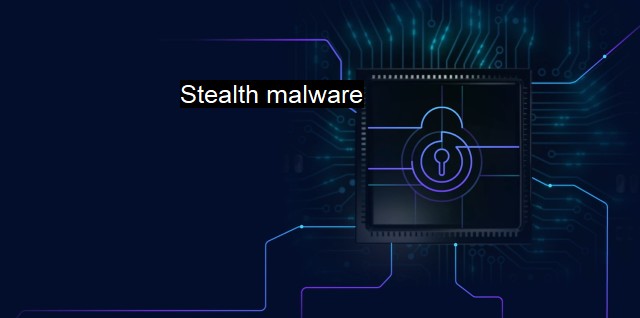What is Stealth malware?
The Art of Deception: Uncovering the Challenges of Detecting Stealth Malware in Cybersecurity
Stealth malware, also known as stealth virus or stealthy malware, is a type of malicious software designed to clandestinely infiltrate or damage a computer or network without being detected by users or security software. It operates covertly, using various tactics to remain undetected, hence its name. Given its secretive nature, stealth malware holds a substantial threat in the realm of cybersecurity.Understanding the mechanisms and characteristics of stealth malware provide valuable information to comprehend just how ominous it can be. It is designed to pervade the security of the system and exploit it, causing severe damage before the user even suspects anything. It could simply be creating a backdoor for the cyber criminals to infiltratively steal sensitive data or conducting a much more devastating task, such as encrypting user data for ransomware attacks, impacting both individuals and enterprises at large scale.
One of the tactics employed by stealth malware is disguising itself within regular-looking files, often attached in seemingly harmless emails or downloadable from dubious websites. Its tricky operation ensures that the malicious payload is delivered securely without triggering alarms. such malware tends to have an ability of sophistication: polymorphic or metamorphic. This capability enables the malware to change its code to bypass security solutions' signatures-based detection, staying ahead of traditional antivirus software.
Another innovative technique utilized by these infections is going "rootkit". That's a stealth malware type that burrows deep into the system – often into the operating system or firmware - and modifies system processes to make itself invisible to the system's security alerts. Hence, it can carry out its mission smoothly for a prolonged time and clean any trace of harmful activities.
Contrary to common perception, stealth malware is not only a threat lurking on the web, waiting to be accidentally downloaded. It frequently comes bundled in legitimate software or can be directly inserted into the memory or hard drive of the device. Consequently, traditional antivirus solutions may fail to detect, leave alone combatting or removing such an insidious threat.
Cybersecurity professionals are in a perpetual battle, amending defenses against stealth malware. This malware's nature is to continuously evolve, making it a menace to keep up-to-date with the attackers' ever-changing tactics. In the same vein, experts develop strategies to detect anomalies, manage vulnerabilities, and establish recovery protocols. They incorporate machine learning and artificial intelligence into their arsenal to predict and effectively counter attacks.
While standard antivirus solutions serve as the frontline of resistance, the agility of stealth malware demands more sophisticated defenses. These involve behavioral-based detection mechanisms capable of identifying unusual system activities, hinting at the presence of malware. Hence, layered security controls significantly help to clear suspicious activities regardless of how covert they seem initially.
Importantly, a robust security posture towards stealth malware must also account for education and awareness as critical weapons. This means there should be an understanding of potential threats and behaviors among users. Individuals and enterprises should exercise caution when handling unfamiliar files, emails, and downloads. regular updates and backups translate into a regular security hygiene that effectively safeguards the system.
Stealth malware in cybersecurity is a sophisticated, continuously evolving threat, which employs ingenious techniques to infiltrate and damage a computer system or network, often remaining undetected by traditional antivirus solutions. By camouflaging in regular files, alter their code, and hiding deep in the device's processes, they manage to carry out destructive actions. To counter such tricks, pursuing layered security controls, behavioral-based detections, supplemented by a culture of knowledge, risk-awareness and preventative practices are pivotal in reinforcing cybersecurity measures.

Stealth malware FAQs
What is stealth malware?
Stealth malware is a type of malicious software that is designed to go undetected by antivirus software and other security measures. It uses techniques such as encryption, code obfuscation, and rootkit installation to hide its presence and evade detection.What are some common types of stealth malware?
Some common types of stealth malware include rootkits, Trojan horses, and backdoors. These types of malware are designed to give hackers remote control of a compromised system, allowing them to steal data, install additional malware, or carry out other malicious activities without being detected.How can I protect myself from stealth malware?
To protect yourself from stealth malware, you should use a reputable antivirus software suite that incorporates real-time protection and advanced threat detection capabilities. You should also keep your software up to date, avoid clicking on suspicious links or opening email attachments from unknown sources, and use VPNs and other security tools when using public Wi-Fi networks.What should I do if my computer is infected with stealth malware?
If you suspect that your computer is infected with stealth malware, you should immediately disconnect from the internet and run a full virus scan using your antivirus software. If this fails to detect or remove the malware, you may need to seek the assistance of a professional cybersecurity expert who can identify and remove the malware manually. You should also change your passwords and closely monitor your financial and personal accounts for any signs of suspicious activity.| | A | | | B | | | C | | | D | | | E | | | F | | | G | | | H | | | I | | | J | | | K | | | L | | | M | |
| | N | | | O | | | P | | | Q | | | R | | | S | | | T | | | U | | | V | | | W | | | X | | | Y | | | Z | |
| | 1 | | | 2 | | | 3 | | | 4 | | | 7 | | | 8 | | |||||||